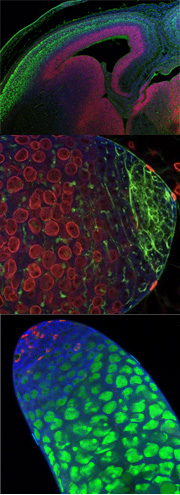
LKB1 regulates cell polarity
|
|||
|
Peutz-Jeghers syndrome (PJS) is a debilitating disease that is caused by mutations in a serine/threonine kinase, LKB1. Loss of LKB1 leads to numerous hamartomatous polyps in patients, as well as a greatly increased lifetime risk for many types of cancers, including colon cancer, lung cancer, breast cancer and pancreatic cancer. The mechanisms by which mutations in LKB1 lead to PJS remain unclear. The C. elegans LKB1 homologue, Par-4, is involved in determining cell polarity in early embryogenesis, along with other members of the PAR family. Loss of LKB1 in Drosophila disrupts polarity of the oocyte, and tissue culture studies have indicated that LKB1 regulates cell polarity in humans. Since loss of cell polarity is a hallmark of many cancers, it has been suggested that the ability of LKB1 to regulate polarity is crucial for the prevention of tumor formation. We are studying the function of LKB1 using the Drosophila eye as a model system. We have found that LKB1 is needed to establish distinct membrane domains in photoreceptors in the eye. The eye undergoes a dramatic remodeling of cell polarity during pupal development. Loss of LKB1 leads to a disruption in the establishment of different domains. We are using a combination of molecular, genetic and biochemical approaches to understand how LKB1 contributes to cell organization.
Figure 1. Remodeling of cell polarity during eye development. The Drosophila retina has a standard apical-basal cell polarity during embryonic and larval development. During pupil development, the cone cells (c.c) grow over the photoreceptors (R1-R8), leading to a loss of a free apical surface. The cells must redefine a new apical surface, which is now the space between the previous apical surfaces (red in diagram). Figure adapted from Longely & Ready.
Figure 2. Apical-Basal cell polarity is normal in LKB1 mutant discs.
Figure 3. Cell polarity remodeling during pupil morphogenesis.
Figure 4. Loss of LKB1 leads to defects in the remodeling of cell polarity
|
|||
 |